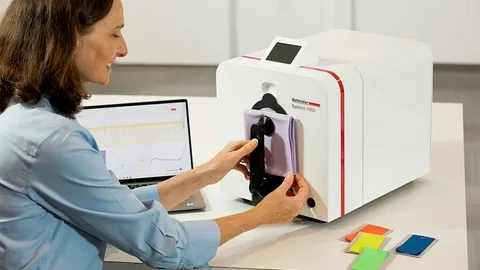Colour looks easy.
Red is red, blue is blue, right?
Not so quick.
A T-shirt sewn in Dhaka can look tomato, while the same code cut in Mexico shouts apple-red.
Light, dye lot, screen glow, and even a dusty lens on the phone twist hue.
Big brands sell millions, so a tiny shade slip turns into a big pile of angry returns.
Good news: digital tricks now help teams shoot, share, and lock colour faster than the old mail swatch way.
Below are simple hacks, told in kid words, that global sourcing crews can learn in one coffee break.
1. Start with one boss file
Every colour story needs one master.
Make a small PNG square, 100 × 100 pixels, filled with the exact LAB number.
Store that file in the cloud box named “DO NOT EDIT.”
Factories, mills, and print shops must copy, never change.
Sounds silly, yet many teams lose shade on the first email because someone drags a file into PowerPoint and it shifts 1 %.
2. Use LAB, not RGB
RGB numbers dance with each screen brightness.
LAB lives closer to how eyes see.
Tell Colour House “send LAB 50 / 70 / 40” rather than “send R 230 G 20 B 90.”
Most printers and dye labs understand LAB; if not, share a free plug-in link.
Little swap, big save.
3. Calibrate screens each month
The laptop grows old.
Blue LED fades a bit.
Dust is stuck on the light sensor.
Use a lunch-box-size puck calibrator, press on the glass, and let it flash for about five minutes.
Do this first Monday of every month.
Put a sticker on the lid, “Cal done 8 July,” so the boss can check quickly.
4. Shoot swatches in a light tent
Phone photo under the office tube light lies.
Buy a cheap pop-up light tent, white cloth sides, two LED strips on top.
Place the swatch flat, tap the screen to lock exposure, snap.
Now, picture matches the real world 90 % better.
Add a colour checker card on the edge, so editing software can auto-fix the balance.
5. Turn the cloud folder into a living wall
Create one online board—Trello, Miro, or even a shared slide.
Column for each colour.
Drop factory lab dip photos under the correct column.
Add simple emoji: ✅ for pass, ⚠️ for close, and ❌ for fail.
The whole team sees the state in one blink, no hunting mails.
6. Teach Delta-E like a traffic light
Delta-E shows how far two colours stand.
Under 1.0 = eyes say the same.
1–2 = okay on garment, only robot sees diff.
2–5 = most shoppers notice.
Over 5 = wrong world.
Print card with three boxes—green, yellow, red—and numbers.
Hang near the dye jet machine.
Workers love pictures more than thick spec doc.
7. Batch proof on low-ink PDF
Before factory prints hang tags or heat transfers, export artwork as PDF/X with output intent set to GRACoL.
Open in Acrobat Output Preview, toggle Simulate Paper.
If the gap looks weird, fix it before the plates run.
Saves both paper and swear words.
8. Label cones and rolls with QR
Stick the QR code on a thread (recycled polyester thread or polyester corespun thread), cone or a fabric bolt.
Code links to the master LAB value and the last measured Delta-E.
Quality crew scan with phone, app pops green or red.
No more guessing which roll is new season bay leaf and which is last year’s olive.
9. Lock naming early
Colour names float.
One buyer writes “Sunrise Coral”, merch sheet says “Light Peach”, PLM shows “S-229.”
Pick one label on day one.
Use the same tag in the file, box, and invoice.
A mismatched name means wrong dye bath half a world away.
10. Create “shadow” approval team
Sometimes the lab dip needs a yes in 24 hours, but the lead designer flies.
Select two backup eyes in each region, train them on the brand tone.
If the time zone blocks the main approver, the shadow can hit go.
Fast move beats holding bulk yarn.
11. Automate reorder alerts
Set a simple rule in PLM: when the preferred mill stock drops below 20 kg, the system emails the colourist.
Dye houses hate rush orders.
Early ping keeps shade stable across style life.
12. Share fails, not just wins
Monthly, post one “colour oops” slide—maybe the batch went pink, maybe the visor logo turned purple.
Write three lines on why.
Team laugh, then learn.
Culture of open miss beats silent repeat.
13. Budget for “sunset drift”
Outdoor gear fades.
Spec starts at LAB X, but after 20 wash + sun it shifts.
Set a target for aged shade, not virgin only.
Test fabric under UV lamp for 24 h, record drift.
Pick a dye recipe that lands correctly after fade.
14. Mix human eye and software
Spectro gives a number; grandma gives a feeling.
Supply chain works best when both talk.
Have tech read the meter first, then two humans sign off under a daylight lamp.
Balance the tech brain and the heart eye.
Wrap up
Colour keeps the brand voice loud.
Get one tone wrong, and the store wall looks messy.
With small digital hacks—single boss file, LAB language, monthly screen cal, live cloud board—global teams hold hue steady from start sketch to last carton.
Tools cheap, rules simple, impact huge.
Like a classroom crayon box, if red, blue, and green stay true, art shines.
Do the easy clicks now; stop big headaches later.

